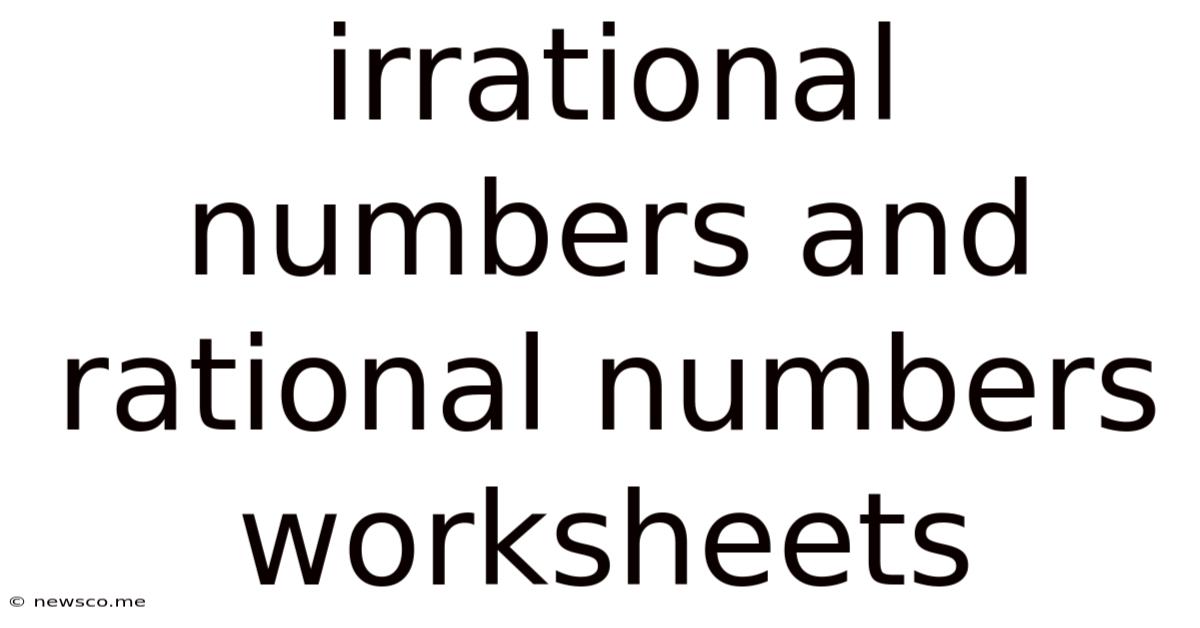Irrational Numbers And Rational Numbers Worksheets
News Co
Mar 15, 2025 · 5 min read

Table of Contents
Irrational Numbers and Rational Numbers Worksheets: A Comprehensive Guide
Understanding rational and irrational numbers is fundamental to grasping advanced mathematical concepts. This comprehensive guide provides a detailed explanation of both rational and irrational numbers, along with numerous examples to solidify your understanding. We'll also delve into how to effectively create and utilize worksheets to reinforce these concepts. This guide is designed to benefit students, educators, and anyone seeking to improve their understanding of these core mathematical ideas.
What are Rational Numbers?
Rational numbers are numbers that can be expressed as a fraction p/q, where 'p' and 'q' are integers, and 'q' is not equal to zero. This means they can be represented as a ratio of two whole numbers.
Key Characteristics of Rational Numbers:
- Fractions: All fractions (where the denominator isn't zero) are rational numbers. Examples: 1/2, 3/4, -5/7, 10/1 (which is the same as 10).
- Terminating Decimals: Rational numbers can be expressed as terminating decimals. These decimals have a finite number of digits after the decimal point. Examples: 0.5, 0.75, -2.25.
- Repeating Decimals: Rational numbers can also be represented as repeating decimals. These decimals have a pattern of digits that repeats infinitely. Examples: 0.333... (1/3), 0.142857142857... (1/7).
- Integers: All integers (positive, negative, and zero) are rational numbers because they can be written as a fraction with a denominator of 1. Examples: -3 (which is -3/1), 0 (0/1), 5 (5/1).
What are Irrational Numbers?
Irrational numbers are numbers that cannot be expressed as a fraction p/q, where 'p' and 'q' are integers, and 'q' is not zero. They are non-repeating and non-terminating decimals.
Key Characteristics of Irrational Numbers:
- Non-repeating, Non-terminating Decimals: This is the defining characteristic. The decimal representation goes on forever without any repeating pattern.
- Famous Irrational Numbers: Some well-known irrational numbers include:
- π (Pi): Approximately 3.14159..., representing the ratio of a circle's circumference to its diameter.
- e (Euler's number): Approximately 2.71828..., the base of natural logarithms.
- √2 (Square root of 2): Approximately 1.41421..., which cannot be expressed as a simple fraction.
- √3, √5, √7, and other square roots of non-perfect squares.
Differentiating Rational and Irrational Numbers
The key difference lies in their decimal representation:
- Rational numbers: Have either a terminating decimal (ends) or a repeating decimal (a pattern repeats infinitely).
- Real Numbers: The union of rational and irrational numbers forms the set of real numbers. All numbers that can be placed on a number line are real numbers.
Creating Effective Worksheets: Rational and Irrational Numbers
Worksheets are crucial tools for reinforcing learning. Here's how to create effective ones focusing on rational and irrational numbers:
Worksheet Design Principles:
- Clear Instructions: Start with clear, concise instructions. Students should understand precisely what is expected of them.
- Gradual Difficulty: Begin with easier problems and gradually increase the complexity.
- Varied Question Types: Include a mix of question types to assess different levels of understanding. Examples:
- Identification: Identify whether a given number is rational or irrational.
- Conversion: Convert fractions to decimals and vice-versa.
- Comparison: Compare and order rational and irrational numbers.
- Word Problems: Apply the concepts to real-world scenarios.
- Visual Aids: Use diagrams, number lines, and other visual aids to improve understanding, especially when dealing with decimals and fractions.
- Answer Key: Always include an answer key to facilitate self-checking and immediate feedback.
Sample Worksheet Questions:
Section 1: Identifying Rational and Irrational Numbers
- Identify each number as rational or irrational:
- 2/3
- √5
- -4
- 0.666...
- π
- 0.123456789
- 0.123123123…
- √9
- 3.14
- -5/9
Section 2: Converting Fractions to Decimals
- Convert the following fractions to decimals:
- 1/4
- 3/8
- 2/3
- 5/6
- 7/11
Section 3: Converting Decimals to Fractions
- Convert the following decimals to fractions (in simplest form):
- 0.75
- 0.3
- 0.625
- 0.1666...
- 0.8333...
Section 4: Comparing Rational and Irrational Numbers
- Order the following numbers from least to greatest: 2/3, √2, 1.5, π, 0.75, √4
Section 5: Word Problems
- A rectangle has a length of √16 meters and a width of 2.5 meters. Is the area of the rectangle a rational or irrational number? Explain your answer.
Section 6: Advanced Problems (for higher grade levels)
- Prove that the sum of a rational and an irrational number is always irrational.
- Prove that the product of a non-zero rational number and an irrational number is always irrational.
- Approximate the value of √7 to three decimal places. Explain your method.
Utilizing Worksheets Effectively
- Regular Practice: Consistent practice is key to mastering these concepts. Incorporate worksheets into your regular study routine.
- Self-Assessment: Use worksheets for self-assessment to identify areas where you need more focus.
- Peer Review: Have students work together to check each other's answers.
- Teacher Feedback: Teachers can use worksheets to assess student understanding and provide targeted feedback.
- Differentiated Instruction: Tailor worksheet difficulty to individual student needs.
Conclusion:
Mastering rational and irrational numbers is crucial for progress in mathematics. Using well-designed worksheets, combined with consistent practice and effective teaching strategies, will significantly improve your understanding and proficiency in this fundamental area of mathematics. Remember to focus on understanding the underlying concepts, not just memorizing facts. The practice exercises in the worksheets will help solidify your understanding and build confidence in tackling more complex mathematical problems. Remember to always check your work and seek clarification when needed. Good luck!
Latest Posts
Related Post
Thank you for visiting our website which covers about Irrational Numbers And Rational Numbers Worksheets . We hope the information provided has been useful to you. Feel free to contact us if you have any questions or need further assistance. See you next time and don't miss to bookmark.